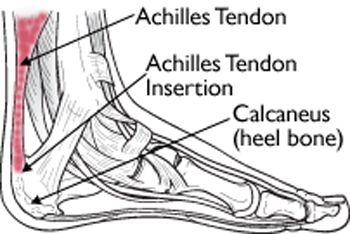Achilles Tendonitis or Achilles Tendinopathy refer to pain / inflammation in the Achilles area. It is commonly an overuse injury seen in sports or jobs requiring repetitive action such as jogging or labouring.

What causes Achilles tendon pain?
Tendons are what connects the muscle to the bone. They are most made up of collagen fibres with minimal vascularity and nerves. When the tendon exceeds it’s load capacity, it reacts and can become painful. The collagen fibres will become disorganized as if it has been overstretched, your body will respond by increasing the vessel and nerve supply to the area to try and fix the problem.
How do I treat Achilles tendon pain?
Treatment mostly consists of getting the load right and not exceeding the load to quickly to avoid re-injuring the Achilles. This may take weeks to months depending on how bad the injury is and how long it has been around for. Achilles Tendinopathies commonly do reoccur if you do return to sport to quickly.
Step 1: Pain reduction phase + isometric phase
Firstly, we must address your pain. This can be relieved by using the RICE (Rest, Ice Compression, Elevation) principle for the first 48hrs to 72hrs. In some cases your may be unable to walk without a limp, crutches to help with weight-bearing may be necessary. A wedge to lift the heel and K-tape can also help reduce pressure on the Achilles in the early stages and make walking more comfortable.
Secondly, research has shown again and again that exercises that load the tendons are vital to improve the state of the tendon. Isometric exercises are to be started immediately, it is important you are guided by what exercise to do because this will depend on how much pain you are in and what your tendon can tolerate!
Step 2: Strength (Isotonic)
Once you are (mostly) out of pain and can hold a single leg calf raise for 45 seconds you are into the second phase of treatment. In this phase we start a strength based program and address the other muscles that contribute to your performance in your desired activity.
Step 3: Energy Storage
You are in phase three once you can achieve 25 single leg calf raises pain free, single leg press 1.5 times your bodyweight and have a similar muscle bulk when comparing calf and quadricep musculature. This may take a while to achieve given the amount of time it take to build muscle (up to 12 weeks).
We do start to include plyometric exercises in this stage, including box jumps, agility ladders and exercises more specific to your sport. It is important to ease into this stage as explosive / plyometric exercises do place a large amount of load on a tendon!
Step 4: Return to sport
It is important to gradually ease into sport, i.e. start with a short run or only play half a game for your first few times re-exercising the tendon when it has more demands placed upon it. It is important to also continue your strength training 2-3 times a week during this phase.
In summary.
Unlike ligament injuries and fractures, the time-frame is different from person to person and mostly depends on how much load your tissue can tolerate during your assessment with the physiotherapist. To reach and complete stage four you need to be compliant with your program and work with your physiotherapist through each stage.

One thought to “Achilles Pain | Ankle Physio Sydney CBD”
Pingback: Running injuries | Sydney CBD | Injury Prevention & treatment
Comments are closed.